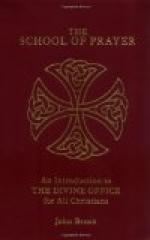Although in the General Rubrics of the Breviary, the title De Festorum praestantia is not found, the four principles, (1)gradation of rite, (2)classification as a primary or secondary feast, (3)personal dignity, (4)external solemnity, are mentioned in the sixth section of Title X., De Translatione Festorum, and the degrees of personal dignity are added in the second section of Title XL, de commemorationibus. Before 1897 precedence, and hence transference, was settled first by the rank of the rite (Double major, etc.); then, too, between two feasts of the same rite, transference was settled by dignity and finally by solemnity. But in 1897 the Sacred Congregation of Rites indicated two further notes to be observed in the weighing of claims for transference, (1)the classification into primary and secondary feasts, (2)the distinction between fixed and movable feasts. This latter distinction—between fixed and movable feasts—has been suppressed by the new legislation and some changes made in the others.
I. Gradation of Feasts makes a distinction between doubles, semi-doubles and simples, and distinguishes the various kinds of doubles. The order of procedure will be—(1)Doubles of the first class, (2)doubles of the second class, (3)greater doubles, (4)doubles, (5)semi-doubles, (6)simples. But as the section shows (Tit. II., sec. i) this is subject to the privileges of certain Sundays, ferias, and octave days or even days within an octave. And hence, an ordinary Sunday, though! only a semi-double, will take precedence of a double; and an octave day, though only a double, takes precedence of a greater double.
II. Classification as a primary or a secondary feast. Tables of classification are to be found in the prefatory part of the new Breviary, under the headings Tres Tabellae. They give a revised list of feasts with their rank and rites. Some feasts are reduced from primary to secondary rank (e.g., Feast of the Dolours); and the tables give a new division of primary and secondary doubles and semi-doubles.
III. Thirdly, the order of precedence among feasts will be determined by the dignity of the person who is the special object of the office that is to be recited. Hence, in the order set down in General Rubrics (Title XI, De Concurrentia officii, sec. 2) all feasts of our Lord, other things being equal, take precedence of the feasts of our Lady. And then, in order, come the festivals of the angels, of St. John the Baptist, of St. Joseph, of the Apostles and other saints. Amongst the saints who are honoured as martyrs, confessors or virgins there is no precedence as to personal dignity.
IV. Lastly, there is the note of “external solemnity,” which may give precedence to one or two feasts, which are equal in the above-mentioned matters—i.e., in Gradation I., Classification II., Precedence III. But the main point is that only doubles of first and second class have the right, as a rule, of transference. Transference is now rather rare.




